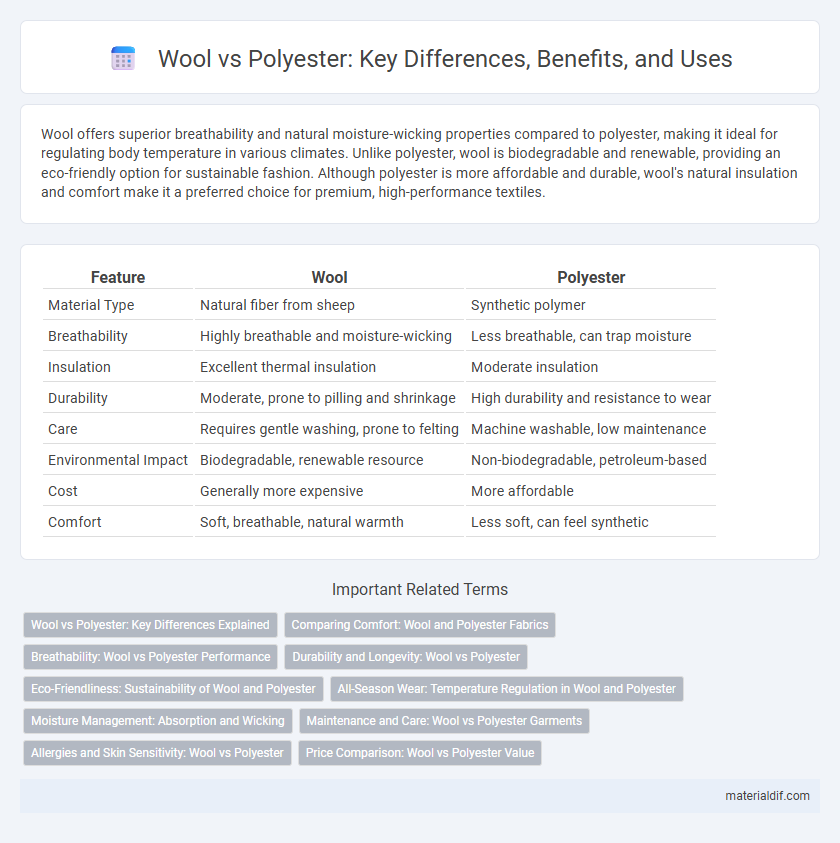Wool offers superior breathability and natural moisture-wicking properties compared to polyester, making it ideal for regulating body temperature in various climates. Unlike polyester, wool is biodegradable and renewable, providing an eco-friendly option for sustainable fashion. Although polyester is more affordable and durable, wool's natural insulation and comfort make it a preferred choice for premium, high-performance textiles.
Table of Comparison
| Feature | Wool | Polyester |
|---|---|---|
| Material Type | Natural fiber from sheep | Synthetic polymer |
| Breathability | Highly breathable and moisture-wicking | Less breathable, can trap moisture |
| Insulation | Excellent thermal insulation | Moderate insulation |
| Durability | Moderate, prone to pilling and shrinkage | High durability and resistance to wear |
| Care | Requires gentle washing, prone to felting | Machine washable, low maintenance |
| Environmental Impact | Biodegradable, renewable resource | Non-biodegradable, petroleum-based |
| Cost | Generally more expensive | More affordable |
| Comfort | Soft, breathable, natural warmth | Less soft, can feel synthetic |
Wool vs Polyester: Key Differences Explained
Wool is a natural fiber derived from sheep, known for its breathability, moisture-wicking properties, and excellent insulation, making it ideal for temperature regulation. Polyester, a synthetic fiber, offers durability, wrinkle resistance, and quick-drying features but lacks the natural breathability and eco-friendliness of wool. Unlike polyester, wool is biodegradable and naturally flame-resistant, enhancing its appeal for sustainable and safety-conscious textile applications.
Comparing Comfort: Wool and Polyester Fabrics
Wool fibers offer superior breathability and natural moisture-wicking properties compared to polyester, making wool garments more comfortable for extended wear. Polyester, being synthetic, tends to trap heat and moisture, potentially causing discomfort and skin irritation. The insulating capability of wool combined with its softness provides a cozy yet breathable fabric ideal for varying temperatures, whereas polyester offers durability but lacks the natural comfort features of wool.
Breathability: Wool vs Polyester Performance
Wool outperforms polyester in breathability due to its natural fiber structure, which allows for superior moisture-wicking and air circulation. Wool fibers can absorb up to 30% of their weight in moisture without feeling damp, preventing overheating and maintaining comfort. In contrast, polyester, a synthetic fabric, tends to trap heat and moisture, leading to less effective breathability and increased sweat retention.
Durability and Longevity: Wool vs Polyester
Wool offers superior durability due to its natural elasticity and resilience, making it resistant to wrinkles, pilling, and abrasion over time. Polyester is strong and resistant to stretching and shrinking, but it tends to degrade faster with prolonged exposure to heat and UV light, which impacts its longevity. Wool's ability to maintain shape and insulation properties even after extensive wear gives it a longer lifespan compared to polyester.
Eco-Friendliness: Sustainability of Wool and Polyester
Wool is a renewable, biodegradable fiber that naturally decomposes without releasing harmful microplastics, making it highly sustainable compared to polyester, which is derived from non-renewable petroleum and contributes to microplastic pollution in oceans. The production of wool supports soil health and carbon sequestration in pastures, whereas polyester manufacturing relies on energy-intensive synthetic processes that increase carbon emissions. Wool's durability and natural insulating properties reduce the need for frequent replacement and washing, lowering overall environmental impact relative to polyester fabrics.
All-Season Wear: Temperature Regulation in Wool and Polyester
Wool excels in all-season wear due to its natural temperature regulation properties, effectively insulating in cold weather and wicking moisture to keep the body cool in warm conditions. Polyester, while lightweight and moisture-wicking, lacks the breathability and thermal adaptability of wool, often leading to overheating or discomfort in fluctuating temperatures. Wool's ability to trap air within its fibers provides superior insulation, making it a preferred choice for versatile, temperature-regulating clothing compared to synthetic polyester fabrics.
Moisture Management: Absorption and Wicking
Wool naturally excels in moisture management by absorbing up to 30% of its weight in moisture without feeling damp, while also wicking sweat away from the skin to keep the wearer dry. Polyester, though quick-drying and hydrophobic, does not absorb moisture but relies on its synthetic fibers to move sweat to the garment's surface for evaporation. Wool's ability to regulate body temperature through superior moisture absorption and breathability outperforms polyester in comfort during variable activity levels.
Maintenance and Care: Wool vs Polyester Garments
Wool garments require gentle care, including hand washing or dry cleaning, and should be dried flat to maintain their shape and prevent shrinkage. Polyester is more durable and easier to maintain, with machine washing and quick drying as common options, making it resistant to wrinkles and shrinking. Proper maintenance of wool extends its lifespan and preserves natural insulating properties, while polyester's low-maintenance care suits everyday wear and active lifestyles.
Allergies and Skin Sensitivity: Wool vs Polyester
Wool is a natural fiber known for its breathability and moisture-wicking properties, making it less likely to cause skin irritation or allergies compared to synthetic polyester. Polyester, being a synthetic material, can trap heat and moisture, often leading to increased skin sensitivity and allergic reactions in some individuals. Wool's hypoallergenic qualities and ability to regulate temperature make it a preferred choice for sensitive skin.
Price Comparison: Wool vs Polyester Value
Wool typically commands a higher price than polyester due to its natural origin, superior insulating properties, and durability, making it a premium textile choice. Polyester, being synthetic and mass-produced, offers a more affordable alternative with lower production costs and easier maintenance. When comparing value, wool justifies its cost through longevity and breathability, whereas polyester appeals to budget-conscious buyers prioritizing price over natural fiber benefits.
Wool vs Polyester Infographic

 materialdif.com
materialdif.com